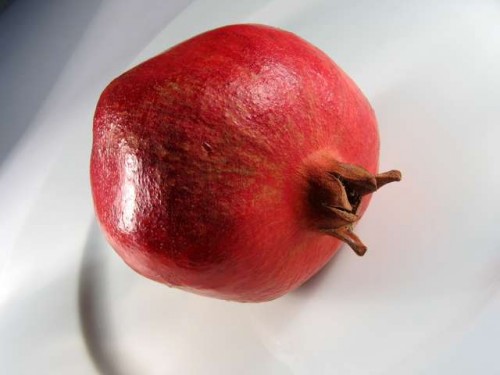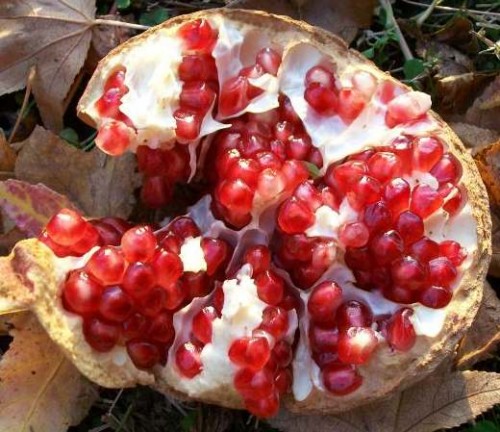|
POMEGRANATE >> Fruitfulness
 The pomegranate is: The pomegranate is:
A fruit-bearing tree, or rather shrub, of the myrtle family, which is cultivated through all the warmer parts of the Old World, from Northern India through Persia, and in all the countries bordering on the Mediterranean. It is indigenous in North Africa and Southern France, and flourishes in Bermuda and many of the West Indian islands.
It is evergreen, and forms rather a collection of small stems…than a single tree, nor does it often exceed eight or ten feet in height. The leaves are lanceolate, glossy, and small, of a very delicate greenish-red color. . . . The bell-shaped blossom is extremely beautiful and conspicuous, varying from scarlet to a deep orange-red, and the fruit, when ripe, is of a bright red color, as large as an orange, and crowned with its calyx, which adds much to its grace of form. . . . It continues to throw out a succession of blossoms from March to June. . . . There are two sorts cultivated in orchards, the sweet and the sour, contrasting in taste like the orange and lemon, though the appearance of the fruit is precisely similar.
The Romans, who introduced the tree from Carthage, gave it the name punicum malum, the Carthaginian apple; and our name pomegranate is derived from the Latin “grained apple,” from the striking appearance of the bright pink pips, packed in compartments separated by a white membrane, shining like rubies, and beautifully arranged. . . .
The bark and the rind of the fruit are powerful astringents, and are used medicinally in the East; but are chiefly valuable as tannin. The rind of the wild pomegranate is still carefully collected in Morocco and the Sahara, and is used exclusively for the preparation of the finest sort of morocco leather, giving it a dull red color. (Tristram, Natural History of the Bible)
The pomegranate, from the abundance of its seeds, was regarded in ancient times as an emblem of fruitfulness. The tree upon which it grows is of a humbler kind than any which has so far been mentioned, being scarcely more than a flowering shrub. We should, therefore, look for its correspondence rather among the good things of natural life and knowledge than among those of interior perception. The idea of fruitfulness probably is correct; and the kind of fruitfulness we can learn with some definiteness from the use made of the pomegranate in the furniture of the sacred Tabernacle.
 Moses was commanded to cause a robe to be made for Aaron in his ministry before the Lord; and it was said: “Upon the hem of it thou shalt make pomegranates of blue, and of purple, and of scarlet, round about the hem thereof; and bells of gold between them round about; a golden bell and a pomegranate upon the hem of the robe round about. And it shall be upon Aaron to minister; and his sound shall be heard when he goeth in unto the holy place before Jehovah, and when he cometh out, that he die not” (Exodus 28:33–35). Moses was commanded to cause a robe to be made for Aaron in his ministry before the Lord; and it was said: “Upon the hem of it thou shalt make pomegranates of blue, and of purple, and of scarlet, round about the hem thereof; and bells of gold between them round about; a golden bell and a pomegranate upon the hem of the robe round about. And it shall be upon Aaron to minister; and his sound shall be heard when he goeth in unto the holy place before Jehovah, and when he cometh out, that he die not” (Exodus 28:33–35).
By the garments of Aaron, who represents the ministry of Divine things from the Lord among men, is meant the Divine Truth in the Lord’s Word and teachings from it. The hem of this garment is the principles of good life and right morality in which all Divine teachings terminate, and by which they are held firmly together. The pomegranates depending from this hem in colors of truth and love and charity, are representatives of the beautiful life springing from these Christian principles; and the golden bells are teachings of the presence of the Lord, with worship from love for Him—the acknowledgment that the good life is from the Lord (Arcana Coelestia #9918, 9921).
Olives are forms of knowledge of the Lord’s goodness; grapes are knowledge of the sweetness and spirit of His wisdom; dates are glad experiences of His salvation; figs are fruits of natural kindness and benevolence; and pomegranates represent abundant natural usefulness based upon Christian charity.
The golden candlestick in the tabernacle of the Israelites was ornamented with pomegranates and flowers. Each of the six branches terminated in “three bowls made like unto almonds, a pomegranate and a flower”; and the central shaft in “four bowls made like unto almonds, their pomegranates and their flowers”; and under each pair of branches of the candlestick was a pomegranate (Exodus 25:31–36). The candlestick of pure gold is a representative of the wisdom of the Lord in the heavens and the Church. Its ornaments were pomegranates with their flowers, because that wisdom is the wisdom of usefulness, and its delights are the perceptions of means and opportunities of usefulness. Its branches sprang in pairs from the pomegranates because the Divine wisdom regards equally what is right and what is good, and both rightness and goodness are essential to wise life, and spring from love for wise life.
Author: JOHN WORCESTER 1875
|
|